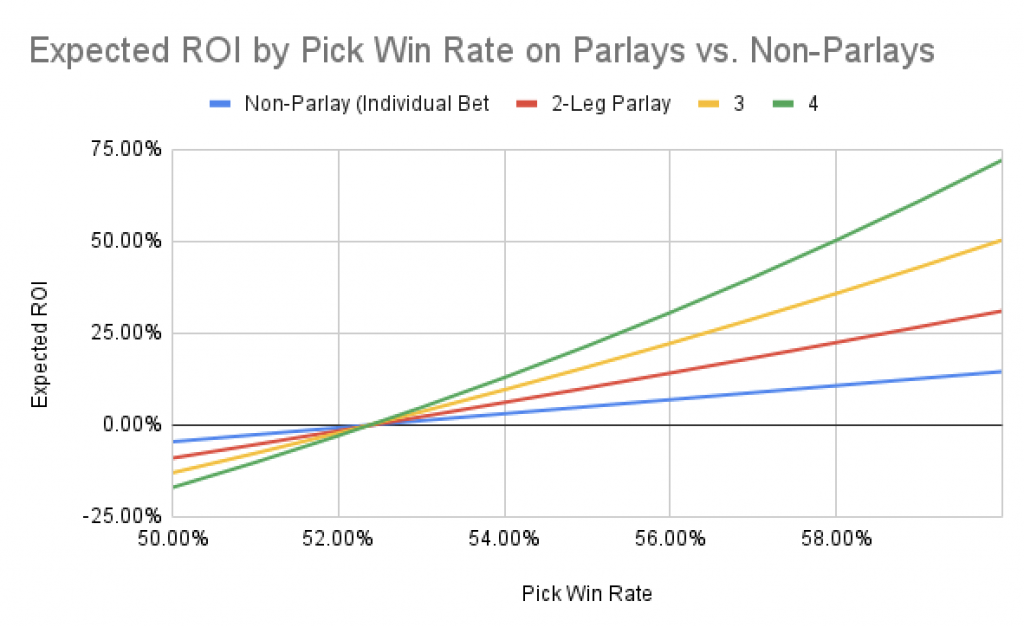American gamblers love the possibility of turning a little bit of money into a lot of money. That’s something we’ve discussed at length at ETR concerning daily fantasy sports and best ball, but it also applies to the popularity of parlays in the sports betting space.
Sportsbooks also love parlays. In January of 2024, New Jersey books held 19.9% on parlays. For reference, if you are a 50% bettor randomly betting into 20-cent lines (-110 each way), the hold is -4.6%. Sportsbooks are holding nearly five times higher on parlays than they would if everyone simply bet without an edge at -110, yet consumers still adore parlays.
Last week, we walked through the logic behind same-game parlays, which really are a different beast than standard combination wagers. Today, we’ll dig into the math behind regular parlays and discuss whether you should have them in your arsenal.
WHAT DO PARLAYS DO?
Parlays increase the amount of money you’re betting and compound your edge. For the first point: If you bet $100 on a straight bet and $100 on a parlay, you may think you’re betting the same amount, but that’s not exactly true. The following excerpt from The Logic of Sports Betting by Ed Miller and Matthew Davidow (a must-read for any sports bettor!) explains this concept better than I can:

Secondly, parlays compound your edge, whether it’s positive or negative. Unlike same-game parlays, they don’t add hidden vig or anything like that. At -110 odds, you must win 52.4% of your bets to be profitable. On a parlay of two -110 bets, you need to win 27.5% of the time — which can also be written as 52.4% multiplied by itself. However, your edge, expressed as a percentage, will be much different betting parlays vs. betting straights. If you win 55% of the time at -110, your ROI is 5%. If you win 55% on -110 legs of a two-part parlay, your ROI is 10.1%. Conversely, if you win 50% at -110, your ROI is -4.6%. Parlay two coin flips together at -110 and that number drops to -9%.

Basically, you need to take a look in the mirror when considering betting parlays because things can get ugly fast if you’re donating 9% (or higher if you’re doing more than two legs) every time you submit a bet.
IS BETTING PARLAYS OPTIMAL THEN AS A WINNING BETTOR?
You may see the chart above and notice that if you are a winning bettor with a 55% win rate expectation at -110 odds, your edge is higher parlaying your bets together. However, dollars earned (and, more precisely, bankroll growth) is more important than expected value expressed as a percentage. Let’s dig into what that means.
You have two plays, each with an assumed 55% win rate at -110 odds. If you risk $100 on both, your expected profit is $10 exactly. If you risk $100 on a +264 parlay, your expected profit is $10.11. Because you are risking twice as much by betting both straight, the difference between the two is only 11 cents despite the parlay having twice the edge. If you risk $110 on each straight bet (since many bettors bet to win one unit on minus odds and risk one unit on plus odds), your expected profit betting two straights is $11 — now higher than the parlay. This is how most bettors — and likely even most winning bettors — stake their wagers, using a standard bet size and/or running into a limit that forces them to play each bet for a certain amount. Plus, this assumes you are using the same unit for a -110 wager and a +264 one, when in reality many gamblers would size down due to the longer odds. If this applies to you, it’s usually best to bet straight despite the sacrificed percentage edge. The exception would be if you’re hitting at a super high clip, the parlay eventually surpasses the straights due to the compounding effect. If your assumed win rate is 70.7% — making the parlay a 50/50 proposition — you’d expect to profit $76.96 on two $110 straight wagers vs. $82 on one $100 parlay. Generally though, betting straight will out-profit parlay betting provided you can risk twice as much.
However, it’s not always an either-or scenario. We discussed in the previous section how parlays effectively make you bet more. You could also take that extremely literally and bet two straights and a parlay if limits are an issue and the line moves. I generally think most people for whom limits are a major concern would render this irrelevant by moving the line. Still, some books may not let you re-bet something straight at a worse but still +EV number, but they would let you use it in a parlay. In that way, parlays are an effective tool for limit circumvention.
Interestingly, if you are a 50% bettor, you actually lose less betting one $100 parlay at +264 (-$9) vs. betting two $110 bets at -110 (-$10). This becomes less interesting when you consider that the optimal financial strategy for a losing bettor is to gamble less, but it’s worth noting nonetheless. You can figure out what’s optimal for you using any sports betting ROI calculator and inputting the juice of the parlay you’re trying to bet and the odds of said parlay hitting (just multiply the individual probabilities together).
If you can quantify your edge using Kelly criterion, parlays are also worse expected value using optimal staking. Elihu Feustel created a tool demonstrating this and wrote the following using the same percentages we used in the example above (two bets with a 55% expected win rate at -110 odds):
“Does the parlay have a higher EV? Yes. But it is absolutely the inferior play here. The straights let you bet much more and at a lower volatility. In this example, if you approached each with Full Kelly, the straight bet strategy of risking 5% per leg would enlarge your bankroll 31% after 100 iterations. The parlay strategy has an optimal risk of only 4% total and would grow your bankroll only 21% in the same time period. What would happen if you pressed and tried to risk 10% of your bankroll on the parlay? You lose money in the long term. After 100 iterations, you have lost nearly a fourth of your bankroll by over-betting!”
Despite the higher edge on the parlay, Kelly criterion instructs you to bet 5.5% of your bankroll on a straight 55% bet at -110 and 3.8% on a 30.3% winner at +264 odds (the parlay) due to the higher volatility of the parlay. The takeaway from this exercise doesn’t change if you use quarter-Kelly, half-Kelly, etc.
In short, as long as you are using rational staking (flat units or limits for most, Kelly for some), betting straight is mostly optimal for bankroll growth over betting parlays, despite the higher percentage edge on the parlays. One final note so as to not leave anything out: If you’re betting Kelly completely optimally, there is some pretty high-level math indicating it’s best to mostly bet straight but also include some parlay action (hat tip to Twitter user @FrankFrijoles for the link).
THEN WHY WOULD SOMEONE BET PARLAYS?
Parlays are sometimes your only option, and they are clearly better than not betting in those instances provided you are a long-term winner. We mentioned one scenario where a book won’t let you re-bet something straight but will let you use it in a parlay. Another is all the forced parlay apps that exist nowadays, such as PrizePicks, Underdog, Sleeper, etc. These apps usually charge more vig than the books, but they are still very clearly beatable, and the edge can be quite high despite the harsh juice based on how parlays compound edge. Pick’em games are under fire from a regulatory standpoint right now — DraftKings and FanDuel don’t like them offering props under a DFS license — but Underdog has transitioned to a more legally sturdy peer-to-peer version of pick’em, and other sites will likely follow. These sites exist because most people have negative edge, which compounds into a massively positive result for the host, but +EV players can generate fairly ridiculous ROIs.
Furthermore, there are rare cases when you can capture correlation that isn’t priced in. Decades ago, you used to be able to bet on huge college football favorites (like Alabama -40) parlayed with the game total over (like 43.5). These events are clearly heavily correlated and books don’t let you parlay them anymore. Last year, the Cubs and Cardinals played a two-game series in London. The Yankees and Red Sox had played in the same stadium with slightly shorter fences in 2019 and scored 50 runs in two games. It was an interesting case because the game was at sea level with stadium dimensions only slightly smaller than the MLB average; the leading theory in the public sphere on the high-scoring NYY-BOS series was less drag on the ball and bouncy turf. Despite all the uncertainty, DraftKings allowed bettors to parlay the under (or over) in both games. Correlated parlays at uncorrelated prices are rare in 2024, but they aren’t gone completely (and if you find an angle, you should keep it quiet because it’ll get fixed quickly if word gets out).
There also exists a theory that betting parlays looks good on accounts, although I can’t confirm this with 100% certainty. However, since most parlay action is square action — as demonstrated by the absurdly high hold percentage — betting parlays could lead to a longer lifespan for winning accounts. With that being said, it’s not like same-game parlays where the books themselves may struggle to identify if a bet is actually +EV; it seems like it should be fairly straightforward for a book to tell if a parlay is good or not based on the same factors they use to identify +EV straight bets.


